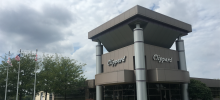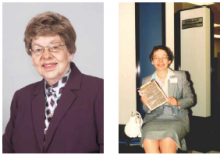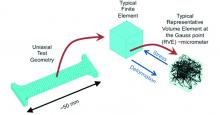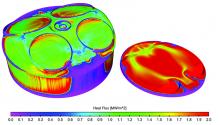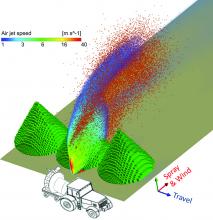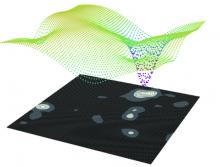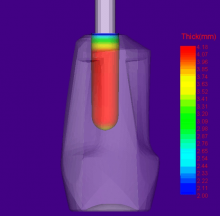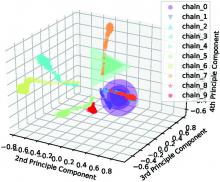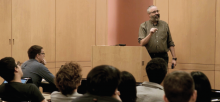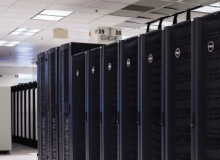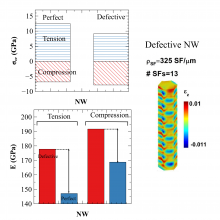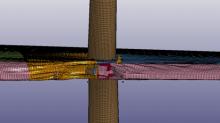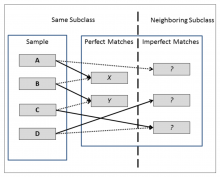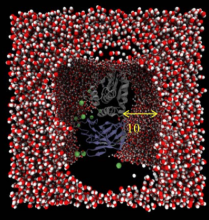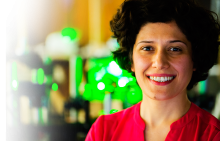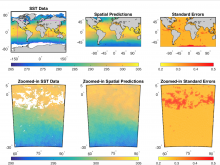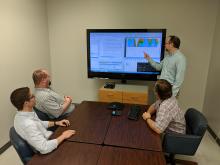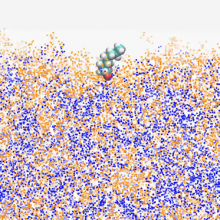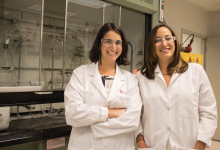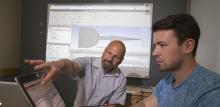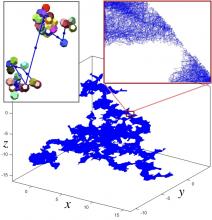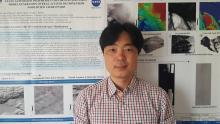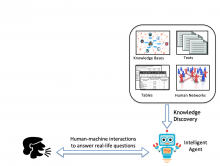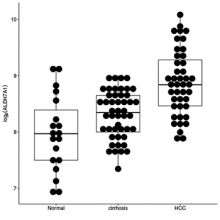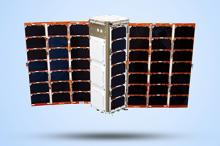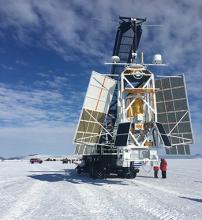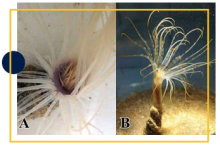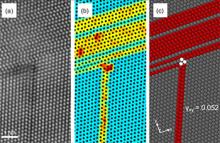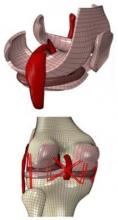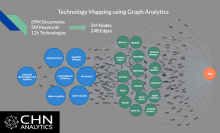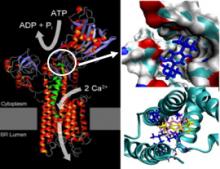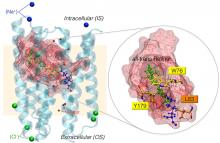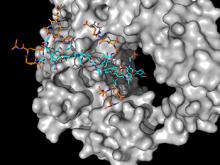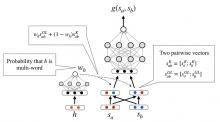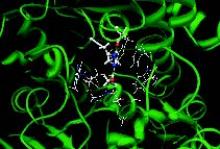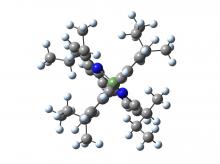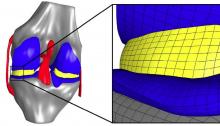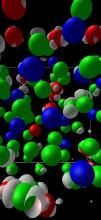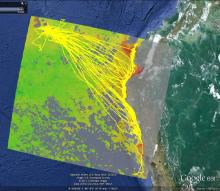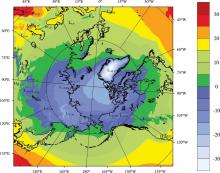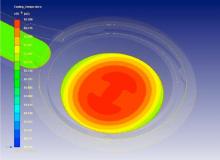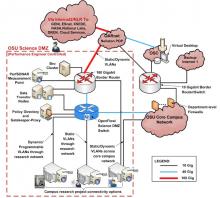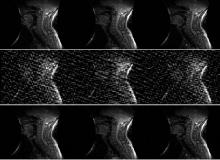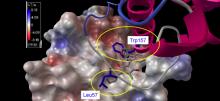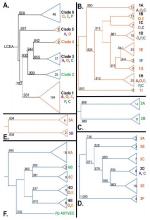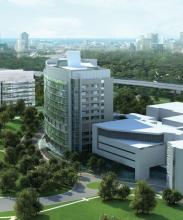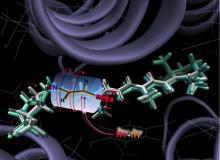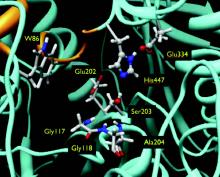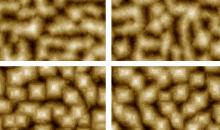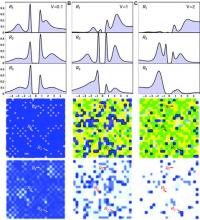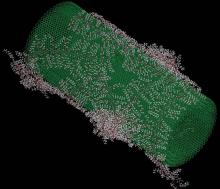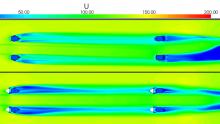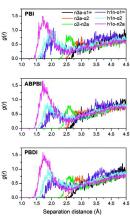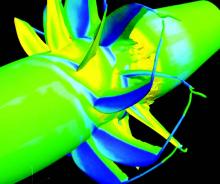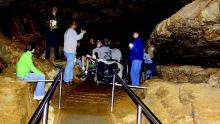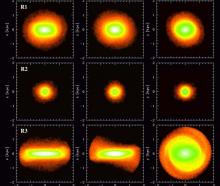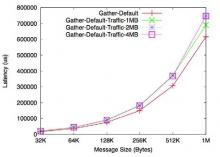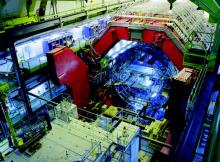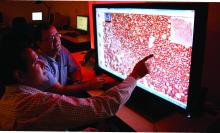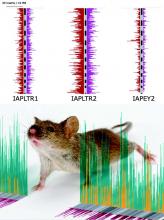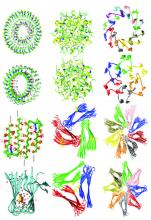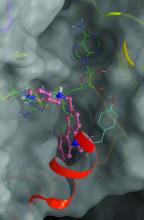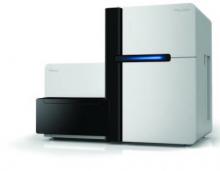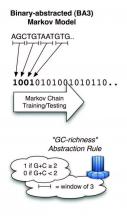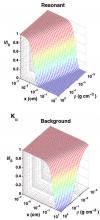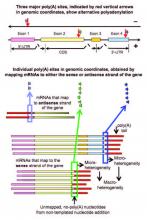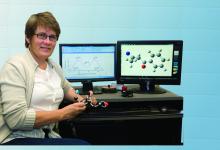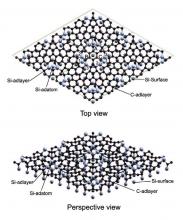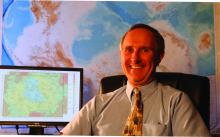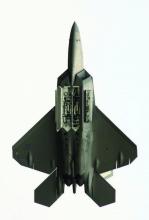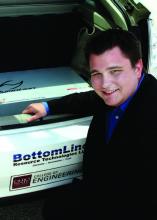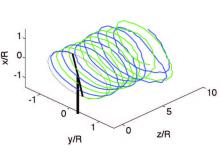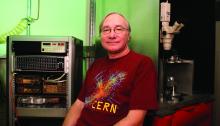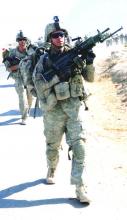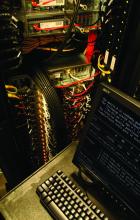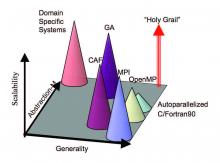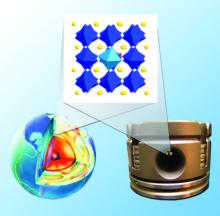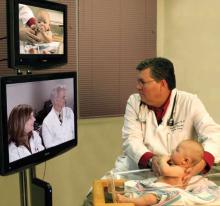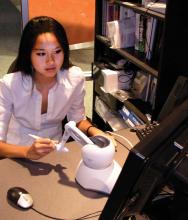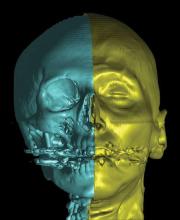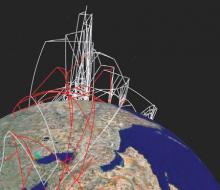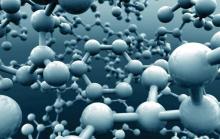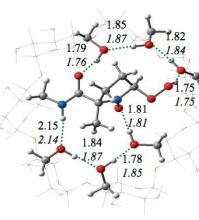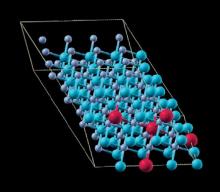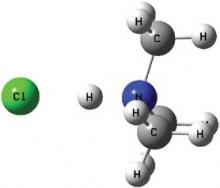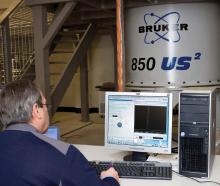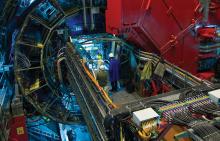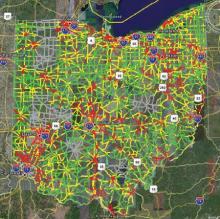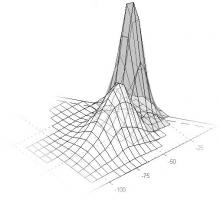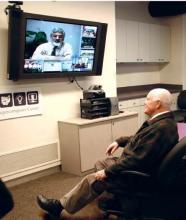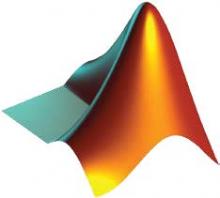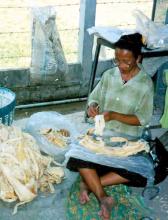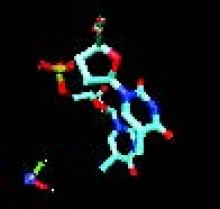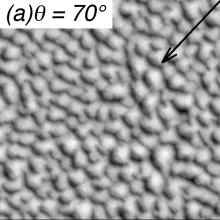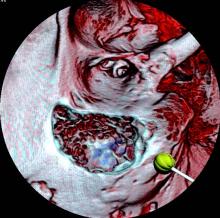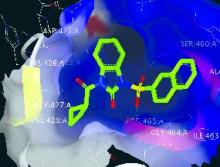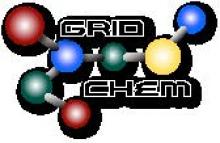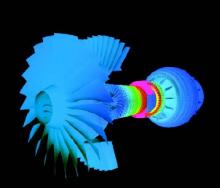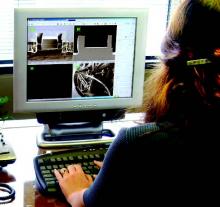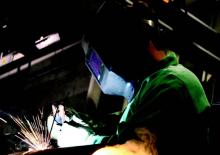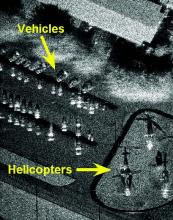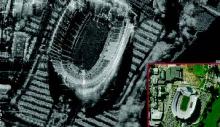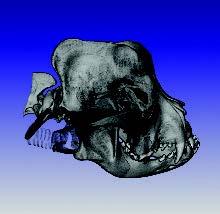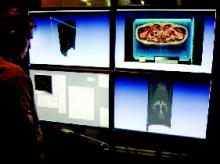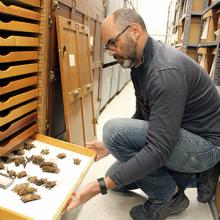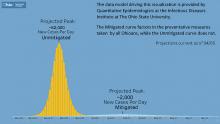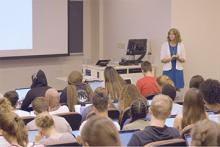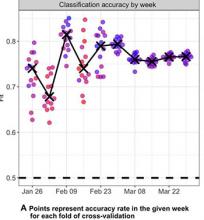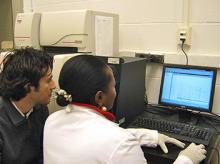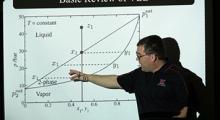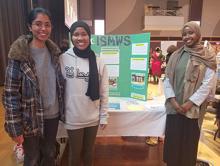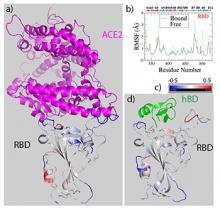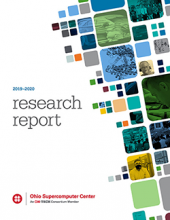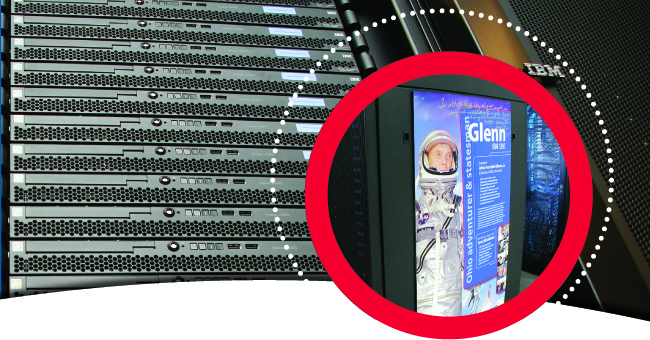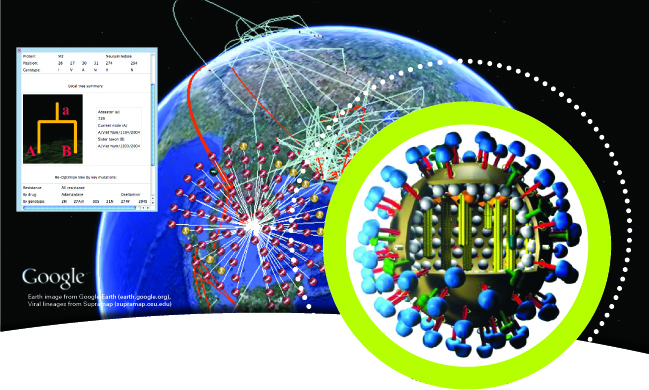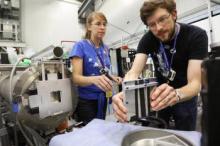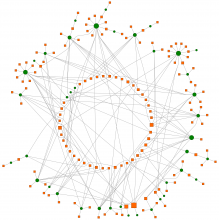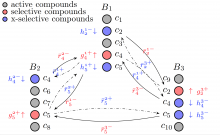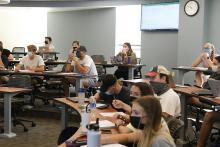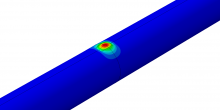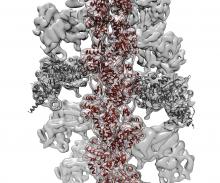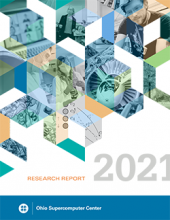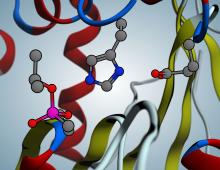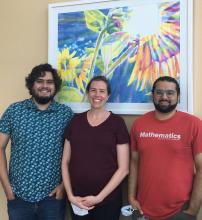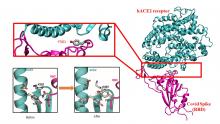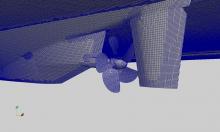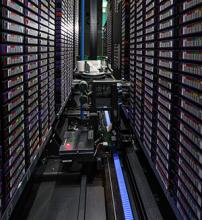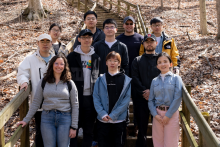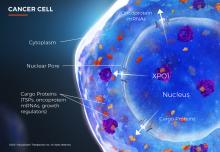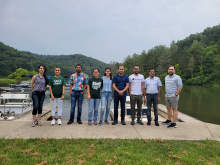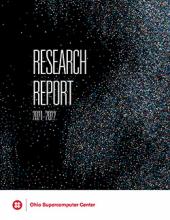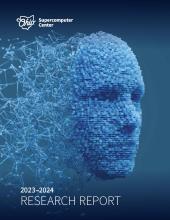At the Ohio State Center for Catalytic Bioscavenger Medical Defense Research II, chemists Thomas J. Magliery and Christopher M. Hadad lead a team that employs sophisticated methods of protein engineering, high-throughput screening and computational chemistry.
2025 Research Report
By investigating the mechanisms of bone formation, researchers at the University of Akron may help develop treatments for bone-related diseases such as osteomalacia, more commonly known as rickets, and osteogenesis imperfecta, a genetic disorder in which bones break easily.
As one of the most common childhood learning disabilities, specific language impairment – a delay in mastering language skills, despite normal hearing, education and intelligence – affects about 5 to 7 percent of all kindergartners.
Malaria affected 219 million people around the globe in 2010, according to the World Health Organization. This life-threatening disease, caused by plasmodium parasites that are transmitted to people through the bites of infected mosquitoes, killed about 660,000 people in 2010 – mostly African children under the age of five.
Erich Grotewold, a professor of molecular genetics and horticulture and crop science at The Ohio State University, is leveraging the resources of the Ohio Supercomputer Center as part of his studies to address fundamentally important questions in plant research.
Colloidal suspension is the term for a substance that is microscopically dispersed throughout another substance and is found in many every day products – food, cosmetics, drugs.
Microdevices, such as Labs-On-a-Chip (LOC) systems, are used for biomolecular detection and custom chemical synthesis, among other applications. Over the last decade, LOC systems have evolved from a single channel to systems capable of integrating thousands of reaction vessels, conduits and valves.
Liquid crystals are at the heart of the technology inside most computer, tablet and smartphone displays today, and researchers are finding more applications for liquid crystals every day – in fields, such as advanced photonics, sensors, bio- and medical molecular devices, and smart materials for new energy applications.
Developing new materials and engineering their novel properties have been the driving forces behind many revolutionary modern technologies. The emerging capabilities in predictive modeling and simulation have created an opportunity to implement the “materials-by-design” paradigm.
Most American highways are constructed as a Portland cement concrete (PCC) slabs that are poured and finished on a layered roadbed. Such pavement structures are subjected to millions of applications of traffic wheel-loads, as well as numerous cycles of temperature and moisture variations, and eventually succumb to cracking.
Carbon dioxide (CO2) is considered an atmospheric trace element, yet also is recognized as a greenhouse gas that has increased significantly since the advent of industrialization.
The flow in the endwall region of a compressor or turbine airfoil passage contains a complex system of vortices, which interact with each other and produce undesirable effects, including the disruption of cooling flows and the generation of aerodynamic losses.
The earth and other celestial bodies are continually bombarded by extremely fast-moving, subatomic particles known as cosmic rays, gamma rays and neutrinos.
The interactions between shock waves from supersonic aerospace vehicles and the airflow immediately adjacent to their exterior surfaces, referred to as shock boundary layer interactions, can have significant effects on the design and performance of wings, control surfaces and propulsion systems.
Coal is currently the largest source of electricity generation in the United States, while gasoline and diesel fuel power most vehicles. However, coal, gasoline and diesel fuel are non-renewable resources, and the combustion of these fossil fuels produces various pollutants. As a result, alternative, non-polluting energy sources such as hydrogen are desirable.
The Venturi Buckeye Bullet 3 (VBB3) is a streamlined electric land-speed race car designed and assembled by undergraduate and graduate students at The Ohio State University’s Center for Automotive Research (OSU CAR).
Object recognition is an important problem that has many applications that are of interest to the Air Force. Object recognition is a key enabler to autonomous exploitation of intelligence, surveillance and reconnaissance (ISR) data, which can make the automatic searching of millions of hours of video practical.
Modern high performance computing systems allow scientists and engineers to tackle grand challenge problems in numerous fields, such as astrophysics, earthquake analysis, weather prediction, nanoscience modeling and biological computations. In concert with the many use cases, the field of computer architecture, interconnection networks and system design is undergoing rapid change.
A new generation of powerful lasers has recently become operational, like the 400 Terawatt Scarlet laser at The Ohio State University (a Terawatt is equal to one trillion watts). These lasers can drive matter to extreme temperatures and densities, applying pressures well over a billion atmospheres.
In a social group, some information is shared by everyone and other information is known only to some members. For example, when analyzing the interactions of college students’ academic performance, it is not likely that a student knows the IQ and/or SAT scores of all the other students in the class.
KLW Plastics, a leading designer, manufacturer and distributor of containers, recently partnered with Kinetic Vision and the Ohio Supercomputer Center to evaluate the effectiveness of advanced modeling and simulation technologies to optimize its container products by lightening their weight, while maintaining the required strength.
Demand for electronic devices of increasingly smaller sizes and with substantially improved processor and graphics functionality has resulted in higher-density power requirements. Consequently, significant increases in heat generated are being registered at the component, board and system levels.
Since the early 1990s, the promise of fuel cells has been onsite power generation with the same round-the-clock availability that has long been the exclusive province of the electric utility industry, but without the cumbersome distribution grid. Engineers at Technology Management, Inc.
A research team recently sought to transform how professionals and students make and learn about advanced manufacturing components through a “simulation-as-a-service” app based on cloud resources and software access. Their application allows users to remotely access software and compute resources using a virtual desktop-as-a-service system for advanced manufacturing processes.
Despite the broad reach and the growth in computational fluid dynamics (CFD) tools and methods over the past two decades, the ability to access this technology remains outside the reach of many small and medium manufacturers (SMM) – the so-called “missing middle.”
For more than 25 years, Ohio Supercomputer Center (OSC) has nurtured its users with a powerful resource for accelerating discovery. The research featured on these pages provides a small snapshot of some of Ohio’s most innovative, and potentially life-changing, studies.
The Ohio Supercomputer Center strives to propel Ohio’s economy, from academic researchers to industrial partners. To that end, Ohio possesses one of the most potent combinations of statewide cyberinfrastructure elements in the world: high-end supercomputing, research leadership and innovative workforce education programs.
Small and mid-sized manufacturers are under constant economic pressure to deliver high-quality, low-cost products. Many large manufacturers have embraced simulation-driven design to achieve a higher degree of competitive advantage.
The Ohio Supercomputer Center’s Virtual Environments and Simulation Group involve an interdisciplinary team of research scientists, computer scientists and clinicians.
The team, which includes colleagues who have been working together for more than two decades, applies high performance computing and advanced interface technology to virtually explore complex computational data.
OSC has earned a national reputation for exceptional training and education programs.
Recent research suggests that long-standing methods for calculating the thermodynamics of ion hydration, while robust, are ambiguous regarding the inclusion of water’s surface potential.
A recent study into the biomechanics of the necks of ants – which can amazingly lift objects up to 1,000 times heavier than its body – might unlock one of nature’s little mysteries and, quite possibly, open the door to advancements in robotic engineering.
Fifty years after the surgeon general first reported on the harmful effects of tobacco, medical professionals continue to find more links between smoking and disease.
Human papillomavirus (HPV) causes about 610,000 cases of cancer worldwide, accounting for about 5 percent of all cancer cases and including virtually all cases of cervical cancer. Scientists have long known that certain types of HPV cause cancer, but they don’t completely understand all the steps that are involved.
Scientists at the University of Akron, in collaboration with partners at UCLA, are investigating the unique properties of metal alloy nanostructures – materials measuring 1-1000 nanometers in length – that have potential applications in the manufacture of fuel cells, batteries, automotive catalysts, sensors and nanoeletronic devices.
In 1978, the Food and Drug Administration approved cisplatin, a platinum-based compound, for clinical use. Cisplatin today is widely recognized as an effective cancer-treating drug, but it also is known to cause many severe side effects, such as kidney damage, nervous system impairment, nausea and vomiting.
A research group at Ohio University has been studying the physics of chemical elements in the oxygen family that lack a crystalline structure, elements known as amorphous chalcogenide materials.
Just one decade ago, researchers first isolated graphene, a carbon film only one atom thick – essentially a semi-metallic material so thin that it presents only two measurable dimensions, length and width.
With more than 120 terawatts of solar power irradiating the earth, photovoltaics offers the promise of essentially limitless energy for powering society. The reality, though, depends on whether the cost of the technology can be made competitive with more traditional carbon-based sources.
Biofuels, fuels derived from plant materials, have the potential to reduce the United State’s dependency on fossil-based fuels. Brent Sohngen, professor of Agricultural, Environmental and Development Economics at The Ohio State University, and his colleagues have developed a series of land use and management models that assess, among many issues, the impact of using forests for biofuel.
A team of field ecologists has concluded that woodland corridors connecting patches of endangered plants not only increase dispersal of seeds from one patch to another, but also create wind conditions that can spread the seeds for much longer distances.
Using the computing power at the Ohio Supercomputer Center, researchers at The Ohio State University are constructing a first-of-its-kind, time-stamped, high-resolution digital surface model of the Greenland Ice Sheet.
The analysis of biological and social networks has become increasingly important in recent years. Inferential and predictive statistical models that analyze networks have been put to use in such areas as epidemiology, public health, molecular biology and the social sciences.
Understanding the different categories of normal facial expressions of human emotion is essential for scientists and doctors in order to gain insights into human cognition and affect, as well as for the design of computational models and perceptual interfaces.
A researcher at the University of Cincinnati is leveraging the compute and storage resources of the Ohio Supercomputer Center to simulate the behavior of elusive cosmic particles. The research team is studying the behavior and nature of neutrinos and the particles’ role in the balance between matter and antimatter.
Machine-based speech separation, often referred to as “the cocktail party problem,” refers to the problem of using computers and other devices to separate target speech from interference caused by background noise.
Aviation industry manufacturers have traditionally relied upon conventional metals and alloys for constructing internal engine parts. During operation, these engines can generate sufficient heat to raise temperatures to within 50 degrees of the melting point of the nickel-based superalloys, titanium, aluminum and steel used in engine construction.
The use of virtual design in the fabrication of large structures has enjoyed significant success in the heavy materials industry for almost two decades. Industries that have used virtual design and analysis tools have reduced material parts size, developed environmentally friendly fabrication processes, improved product quality and performance and reduced manufacturing costs.
High-temperature, solid-oxide fuel cells (SOFCs) are efficient electrochemical devices that produce electrical power from hydrocarbon fuels. SOFCs have received increasing attention in recent years as a clean and efficient power source for use in distributed power-generation applications.
The Procter & Gamble Company, also known as P&G, is an Ohio-based multinational consumer goods company with manufacturing operations in approximately 70 countries worldwide. P&G markets a wide range of products, including cleaning agents and personal care products.
Here at the Ohio Supercomputer Center, we take great pride in providing powerful resources to help accelerate discovery.
The raw data tells part of our story: In 2013, the Ohio Supercomputer Center delivered more than 82 million CPU core-hours, for more than 3.3 million jobs. But behind these numbers lies the rest of our story: OSC exists to enable science.
Since the center’s creation in 1987, the Ohio Supercomputer Center (OSC) has worked to propel Ohio’s economy, from academic discoveries to industrial innovation. The Center provides researchers with high-end supercomputing and storage, domain-specific programming expertise and middle school-to-college-to-workforce education and training.
Supercomputers are powerful, yes. But they are only as powerful as the codes researchers write for them. Brian Guilfoos, HPC client services manager at the Ohio Supercomputer Center, understands that high performance computing isn’t always intuitive and that education and training are essential services.
User Training
When the Ohio Supercomputer Center was established through a state operating budget bill in 1987, it was “intended that the center be made accessible to private industry as appropriate.” Later that year, the Ohio Board of Regents created the Center “as a statewide resource designed to place Ohio’s research universities and private industry in the forefront of computational research.” Making thi
When we think of supercomputing resources, we automatically think of processors and petaflops. However, compute capacity is only one part of the equation; software is another important component.
The Web and Interface Applications Group controls the way in which OSC HPC clients access and use most OSC systems.
Virtual environments, once seen only as a unique extension of gaming technology, now are considered essential tools for competitiveness, from healthcare to education to manufacturing. The Ohio Supercomputer Center’s Virtual Environments and Simulation Group use this technology to create rich, precise, interactive simulations for training, assessment and remote collaborations.
Plexins receive guidance cues from other proteins and transmit signals through the lipid membrane, regulating cell migration and targeting processes. However, if a signal is not transmitted correctly through plexin, studies have shown that this could result in serious neurological disorders.
Keith Marsolo and his team are developing novel techniques that could be used to more quickly identify patients whose bodies no longer respond to standard-use antibiotics. Sick children at CCHMC can develop this resistance after the many rounds of different antibiotics they receive to ward off infections from their weakened immune systems.
The oldest forms of life on Earth, bacteria and archaea, have managed to evolve and adapt to Earth’s changing environment over billions of years. As a result, bacteria and archaea could hold the answers to the persistence of complex life.
Since the creation of the Ohio Supercomputer Center (OSC) in 1987, the center’s staff has provided the critical services that allow Ohio researchers, professors and students to achieve great new levels of success, from empowering amazing scientific discoveries to partnering on remarkable industrial innovations.
Client Services is the entry point for our user community. We provide the connections to the services that OSC offers its clients, and we do that in a number of ways. We manage the administrative functions associated with research done here. We also provide the technical support through a recently expanded 24/7 help desk.
With the April dedication of OSC’s newest cluster, the Ohio Supercomputer Center currently is offering researchers three mid-sized high performance computing (HPC) systems: the HP/Intel Xeon Phi Ruby Cluster, the HP/Intel Xeon Oakley Cluster and the IBM/AMD Opteron Glenn Cluster.
By Pankaj Shah, Executive Director, OSC and OARnet
In 2014, Ohio Supercomputer Center clients at Ohio’s public research universities accounted for $146 million—or nearly 19 percent—of the $780 million in active-award funding awarded to those universities from three of the largest federal research-funding agencies.
While virtual environments often are associated with gaming and entertainment, OSC’s Interface Lab has translated the technology into effective training and assessment tools for use by various sectors such as the health care, automotive and manufacturing industries.
Karen Tomko understands the challenges software developers face, having worked directly on development teams in the past. One of the main barriers is finding ways to make sure the applications that get developed are available and working in a given system.
For those intimidated by the thought of “talking” with supercomputers, Basil Gohar wants to help. As the manager of the Web and Interface Applications group, Gohar and his team have a big goal in mind: Deliver the benefits of powerful computing to users without perceived or actual complexities.
It’s staggering to consider the myriad ways in which the Ohio Supercomputer Center and the AweSim industrial engagement program benefit a wide array of industries. It is also hard to conceive how few leaders in these industries know what they could be gaining from the innovative cloud-based simulation application platform.
Since the first meeting of the Statewide Users Group (SUG) in November 1986—almost a full year before the official 1987 establishment of the Ohio Supercomputer Center by the Ohio Board of Regents (now the Ohio Department of Higher Education)—Ohio research practitioner-advisors have been providing OSC’s leadership with sage program and policy advice.
Phonons — the elemental particles that transmit both heat and sound — have magnetic properties, according to a landmark study conducted by a research group from The Ohio State University and supported by the Ohio Supercomputer Center.
The compelling need for energy efficiency in the transportation industry provides a strong motivation for the increased use of lightweight engineering materials such as titanium and magnesium alloys that will lead to weight reduction.
The quest to understand the fundamental building blocks of nature and their interactions is one of the longest-running and most ambitious of human endeavors.
Several years ago, a Physics World article posed the question, “Why would anyone still want to study a physical phenomenon that was discovered in the 1930s, explained in the 1960s and has been the subject of numerous reviews since the 1970s?”
Water, water everywhere, but it’s all locked underground. Wendy Panero, Ph.D., and The Ohio State University Mineral Physics Research Group have found that minerals within the earth’s mantle potentially contain a vast amount of water.
Researchers who normally use high-resolution satellite imagery to study glaciers used their technology to help with disaster relief and longer-term stabilization planning efforts in Nepal.
The Department of Energy supports pilot projects and basic research that evaluate the feasibility of capturing carbon dioxide created by industrial processes and power plants and injecting it into deep geologic formations for permanent storage, known as geo-sequestration. This is part of evaluating strategies for reducing atmospheric emissions and mitigating accumulation of greenhouse gasses.
Compared to its centuries-old fossil fuel counterparts, nuclear power is a young player in today’s lineup of energy sources. Still, since the world’s first nuclear power plant became operational in 1954, there have been three marked advancement periods, or generations, of nuclear technology. Each new generation has improved upon the current safety and performance of the previous generation.
To begin understanding dark matter in astrophysics, one must first step into a world where galaxies are considered small. The is the world that Annika Peter, Ph.D., and graduate student Stacy Kim are discovering more fully at The Ohio State University’s Center for Cosmology and AstroParticle Physics.
In most of the standard equilibrium models used to explain equity market performance, the volatility of stock market returns is far too low. This muted volatility is closely related to the equity premium puzzle, a phenomenon whereby returns on “risky” stocks are historically much higher and more volatile than returns on “safer” government bonds.
For all the different moving parts that go into mechanical engineering systems, the gas turbine is a relatively simple design: a large rotor fitted with vanes is made to revolve by a fast-moving gas flow.
The noise from jet-engine exhausts can cause substantial hearing loss for crewmen and airport personnel and activate restrictive regulations and/or fees for airlines. The large turbulent eddies within the jet plume—also known as large-scale coherent structures—produce the majority of the noise in the aft angles of the engine.
Drive a car not originally built for racing around an oval track at about 200 miles per hour for a couple of hours and you should begin to understand why stock car drivers would want the latest and greatest information on things, such as how their car will handle in close traffic on a banked curve.
A $5 million gift from Honda R&D Americas Inc. prompted the April 2015 launch of a center for virtual simulation and modeling of product performance and manufacturing processes in the College of Engineering at The Ohio State University.
In the five years since inception, Rescale is making waves in the cloud-computing world.
As one of North America’s largest manufacturers of rigid metal and plastic containers, BWAY Corporation is a global market leader in packaging solutions for large and small manufacturers and container distributors. Traditionally, the company’s engineers and designers have relied on outsourcing the analysis and simulation of new product designs.
In 2016, the Ohio Supercomputer Center arrived at another crossroads. We began installation of the most powerful supercomputer in the history of the center. We swapped out almost all of our storage and other infrastructure, essentially rebuilding OSC’s production infrastructure from the ground up.
In less than 10 years, the way genetic data has been collected has sped up in a major way. Previously, collecting data from a species was done one gene at a time, on an individual-by-individual basis, but new sequencing technologies allow researchers to process hundreds of thousands of genes at a time.
The difference between hearing and a lifetime of silence sometimes lies in the integrity of tiny inner ear proteins. Before Marcos Sotomayor, Ph.D., began studying these proteins, very little was known about hearing at the molecular level.
Sometimes numbers can be startling.
For instance, natural rubber is used in 50,000 commercial products, including 400 medical devices, because of its unique properties with regard to resilience, elasticity, abrasion and impact resistance, efficient heat dispersion and malleability at cold temperatures. It’s a critical raw material that developed countries simply can’t live without.
A critical first step oncologists must take after finding a patient has breast cancer is to look for overexpressed hormone receptors in the cancer cells. This determines the type of therapy that will be used to most effectively combat the disease.
When your business is manufacturing valves, predictable and controlled fluid flow is essential. So when Clippard Instrument Laboratory, Inc. encountered a proportional valve that wasn’t delivering consistent performance, they knew they needed to take a closer look at the issue.
The performance of semiconductor devices such as solar cells, detectors, etc., depends strongly on the properties of materials used in their fabrication. Deep understanding of these properties and the ability to tune them is critical for the development of new generations of advanced photovoltaics and electronics.
Advanced Numerical Solutions (ANSOL) is proof the industrial engagement efforts of the Ohio Supercomputer Center (OSC) are quite beneficial to the “little guy.”
Nimbis Services Inc., a charter partner of the AweSim industrial engagement initiative led by the Ohio Supercomputer Center, has been delving into access complexities and producing, through innovative e-commerce solutions, an easy approach to modeling and simulation resources for small and medium-sized businesses.
Bharat Bhushan, Ph.D., was on sabbatical at Ecole polytechnique federale de Lausanne, Switzerland in 2005 when a transformation began.
After reading an article in a trade magazine on the lotus leaf’s water repellant properties, Bhushan’s industrial research launched down a greener, livelier new path.
To enable the rational design of future materials, such as batteries that could more safely and efficiently power electric cars, a research group at The Ohio State University is developing an innovative modeling approach to reveal the details of the microscopic structure and dynamics in microphase-separated polymer electrolytes.
One of the grand challenges in materials science is discovering exactly how materials form glasses.
David Simmons, Ph.D., an assistant professor in the University of Akron’s Department of Polymer Engineering is trying to understand at the fundamental level the relationship between the molecular structure and the way a material forms a glass.
Alfred Nobel, namesake of the Nobel Prizes, was originally known for inventing dynamite, though not fondly, as he found out. When his brother died, a newspaper erroneously reported Alfred’s death. The obituary chided him for his invention that, especially at that time, often proved deadly.
Consumption of energy is increasing worldwide due to the steady increase in the human population and the long-term growth of the international economy. A group of researchers at a northwestern Ohio science lab have been leveraging Ohio Supercomputer Center services to investigate solar-based fuel production as a sustainable alternative to fossil fuels.
When considering an electric vehicle, many motorists encounter a paradox: they would be willing to make the leap if there were more support infrastructure for them. Conversely, investors might loosen the purse strings to fund electric vehicle infrastructure, such as charging stations, if more people drove them.
In the summer of 2012, the federal government handed the auto industry a major technological challenge by setting a fuel-economy goal of 54.5 miles per gallon as the industry standard by 2025.
By comparison: In 2012, the standard was 29.7 mpg, which was raised to 35.5 mpg in 2016.
Antarctica is more than five million square miles of vast, frozen ice and rock marked by bone-freezing temperatures, high winds, no running water and few signs of life. But what it lacks in accommodations, it makes up for in something important to the rest of the world: Information.
The clouds above our heads provide some of the biggest uncertainties in weather prediction, but a better understanding of their layers could unlock answers.
A research team at Bowling Green State University has been employing Ohio Supercomputer Center systems to better understand the photochemistry of halogenated hydrocarbons. Their study will contribute to a general understanding of solvent environmental effects on chemical reactions and, perhaps, to the ability to control chemical reaction pathways using ultrafast laser techniques.
Matthew Sullivan, Ph.D., gets priceless reactions when he shares a fun fact from his studies: There are over 50 million viruses in one mouthful of ocean water. Before you cancel your beach trip, these viruses infect microbes, not humans. Sullivan’s lab at The Ohio State University studies and catalogs these viruses, using data processing from the Ohio Supercomputer Center.
When life-threatening weather events loom, forecasters warn citizens days, even weeks, beforehand so they can take action. It seems to work: We clear supermarket shelves, board up windows and even evacuate to higher ground ahead of the impending tempest to avoid danger.
Blind to bias in its threat to human life is another force of nature – epidemics.
Within the Ohio State University’s Computational Memory Lab, Per Sederberg, Ph.D., studies the successes and failures of human memory. Part of his work includes developing computational models to link neural activity and behavior to guide experimental work.
While it’s a chore most parents dread, properly installing a car seat is one of the most important things they can do to protect their child. Yun Seok Kang, Ph.D., a research scientist at the Injury Biomechanics Research Center (IBRC) at The Ohio State University, is working toward making child restraint systems (CRS) even safer.
How do we as individuals learn from our social networks? From whom within our communities is it best to learn? And what makes some communities more innovative than others?
A melting pot of eye-opening scientific research projects immersed attendees of the December 2015 Statewide Users Group (SUG) meeting at the Ohio Supercomputer Center (OSC).
In late 2015, an engineering services provider developed a computational fluid dynamics (CFD) app that allows college students on Formula SAE (Society of Automotive Engineers) teams to perform aerodynamics simulations on Ohio Supercomputer Center systems and get wind tunnel-like data for development of their race cars.
In 2016, OSC brought on board the largest supercomputer in its history. Its name pays tribute to renowned Olympic sprinter, beacon for racial equality and youth advocate James C. “Jesse” Owens.
The Ohio Supercomputer Center is much more than a dark room full of glittering, powerful hardware, a fact that our clients discover the moment they request an account to perform whatever research they need done.
The Dunietz Group at Kent State University is researching key processes in material science at a very fundamental level. The computational group led by Barry Dunietz, Ph.D., provides molecular-level insight into charge-transfer processes through various molecular interface to understand the structure effects on the motion of electrons.
With the passage of the state operating-budget bill in 1987, the Ohio Supercomputer Center was established “as a statewide resource available to Ohio research universities both public and private. It is also intended that the center be made accessible to private industry as appropriate.”
Over 96 percent of the water on Earth is undrinkable and unusable for most human purposes. While removing salt from ocean water is possible, desalinated water costs up to ten times more than typical groundwater.
Janet Del Bene, Ph.D., has dedicated five decades to research in theoretical chemistry. And she’s done it with, and without, the help of the Ohio Supercomputer Center. Of course, the only time she didn’t use the Center’s high performance computing capabilities was when they didn’t exist.
From solar cells to electronic tools, new devices are created every day by combining two or more different materials to create a heterogenous interface. Those interfaces play a major role in how those devices function.
In his classroom, Andrew Paluch, Ph.D., is not only teaching classical theories but is also training new generation of supercomputer-savvy scientists.
The rise of antibiotic resistance among common infectious bacteria is a worrisome health threat that has many scientists looking for a solution. Jennifer Hines, Ph.D., professor of chemistry and biochemistry at Ohio University, is one of the few looking to ribonucleic acid (RNA) structures for new drug discovery.
In the Department of Genetics at Case Western Reserve University, Thomas LaFramboise, Ph.D., and his research team are discovering which genetic mutations determine a person’s susceptibility to developing leukemia.
For patients facing chronic lung disease, the third leading cause of death in the U.S., the ultimate end-stage treatment is a lung transplant. Unfortunately, the survival rate for lung transplant patients is lower than that of other organ transplants due to infections and tissue rejection.
Tricuspid valve surgery is a common heart valve procedure in the United States, but it is one with poor long-term outcomes. In fact, studies show that up to 45 percent of those who receive tricuspid valve surgery suffer a recurrence of problems, in some cases as early seven years after surgery. In one-third of the cases, a second operation is required.
Central State University’s Subramania Srithrahan, Ph.D., is fine-tuning a product that could result in clean renewable energy, new jobs and better boating and swimming safety on the nation’s rivers.

With the rise of energy storage applications for such things as rechargeable Lithium ion batteries and solar cells, graphene and graphene-based nanocomposites have attracted a lot of interest.
For most energy applications, heat is a byproduct of a reaction, cast off as unusable energy. But as the world moves toward energy efficiency, scientists are looking at ways to effectively channel heat possibly back into electricity, so less energy is wasted.
More than 140 years ago, when the first four-stroke cycle, internal combustion engine was invented, it became the prototype for the modern automobile powertrains. As long as those engines have existed, however, “knock” has been a limiting factor to the performance of engines.
With the help of the Ohio Supercomputer Center, Ahmet Selamet, Ph.D., is tackling that problem head on.
Going back to the 1990s, a significant amount of research has been dedicated to the rates of deforestation in the Amazon and what this could mean for climate change throughout the world. Additional studies have focused on climate change impacts to Andean mountain glaciers that lie downwind of the Amazon.
The agricultural industry strives to maintain a balance between keeping up with consumer demand and maintaining a safe, clean and sustainable environment – for humans and animals. Linying Zhao, Ph.D, and her research group at The Ohio State University, conduct research to find solutions that help the industry strike this balance.
Understanding particle physics gives us answers to the fundamentals of science. To better understand particle physics, Tom Giblin, Ph.D., looks to cosmology, the study of the evolution of the early universe.
While most of us try to distance ourselves from biting, blood-sucking creatures, Josh Benoit, Ph.D. and his research group at the University of Cincinnati spend their days getting to know them very well – down to the genes and genomics. The idea is the more we understand ticks and other blood feeding arthropods, the better we can avoid and eliminate them.
In 2017, OSC, in partnership with Scientel IT Corp, displayed the power of the Owens Cluster by running the single-largest scale calculation in its history.
Scientel IT Corp, a Big Data specialist company, used 16,800 cores of the Owens Cluster to test a new database software optimized to run on supercomputer systems. The seamless run created 1.25 Terabytes of synthetic data.
“Innovation” is not merely a buzzword thrown around at Procter & Gamble. It’s at the heart of everything the Ohio-based multinational consumer goods company does, and high performance computational modeling and simulation is a major enabler.
When Richard Hughes, Ph.D. set off to found his own data analytics company, The Ohio State University physics professor stuck with what he knew: proprietary algorithms, machine learning and use of the Ohio Supercomputer Center’s high performance computational resources.
How many languages can you name? Ten? Twenty? More?
It is estimated there are more than 7,000 languages worldwide. For those involved in disaster relief efforts, that breadth and variety can be overwhelming, especially when addressing areas with low resources.
In 2017, 44.2 million Americans held student loan debt, totaling more than $1.4 trillion, according to the U.S. Federal Reserve. With the cost of tuition rising at most higher education institutions and enrollment increasing, these numbers are expected to keep climbing.
The lifeblood of manufacturing development hinges on increasing production, lowering costs and deftly overcoming any engineering problems that may arise. The backbone of any industrial facility is the mechanisms by which products are produced.
Research using Ohio Supercomputer Center resources continues to break new ground, and OSC clients continue to gain more high performance computing power and a better experience.
Statewide Users Group conferences in October of 2016 and April of 2017 brought OSC representatives face-to-face with clients and the research being done on their supercomputer clusters.
OSC employs subject-matter experts to assist with individual client requests. For any issues that arise, OSC’s 24/7 support desk is available to respond to client inquiries at any hour of any day. Level 2 and 3 support is available during normal business hours.
Cluster Computing
More than 200 clients attended OSC training sessions this past year, most at their home institution. OSC training and education experts visit campuses all around the state to provide personalized instruction, facilitate classroom projects, train students on the basics of supercomputing, and demonstrate OSC’s broad service offerings.
In March 2017, OSC unveiled the most powerful system in the history of the Center, the Dell/Intel Xeon Owens Cluster. The name pays tribute to renowned Olympic sprinter, beacon for racial equality and youth advocate James C. “Jesse” Owens.
Stephanie Karhoff grew up on farms with broad fields of soybeans, wheat and corn.
From wind turbines to motorcycles, Virginia-based Afton Chemical Corporation produces fuel and lubricant additives to increase performance and efficiency such as fuel economy. To stay on the cutting edge of fluid performance as well as industry standards, Afton’s scientists have to create new additives and formulations.
The world of personalized medicine is rapidly expanding, with advances in DNA sampling, expanded patient charts and more creating individualized treatment plans for more diseases and conditions every day. A researcher and his team at the University of Cincinnati are currently making way for precision medicine – in the mind.
Hamed Attariani’s lab can’t look past the flaws in the materials they study – and that’s exactly the point. Attariani, assistant professor in Wright State University’s department of mechanical and material engineering, is flipping the script in the field of nanostructures by exploring how inherent defects in materials could enhance their mechanical properties rather than deteriorate them.
It’s a bit frightening but in the past, to understand how safe an airplane was, engineers had to wait for a crash. There wasn’t much physical testing that could be done, like with cars.
The 1960s Soviet/U.S. space race put men on the moon but also developed basic technologies that would result in subsequent breakthrough inventions in related fields: prosthetics, water purifiers, freeze-dried foods, satellite television, memory foam and many more. These advances were wrought from federally funded research and today serve the interests of broad swaths of the general public.
Improving the tires we drive on can go a long way in improving the overall efficiency of operating the cars we drive.
Charis Eng, M.D., Ph.D., takes a gene-informed approach to personalized risk assessment and medical management of her patients and families. Her patient-focused research in genes, when altered, or mutated, associating with specific clinical features, such as cancer and autism spectrum disorder (ASD), provides the scientific evidence on which she practices precision medicine.
Weld-induced distortion is an expensive and time-consuming problem for manufacturers of heavy equipment to overcome. However, modeling and simulation can be a major tool to help manufacturers predict and understand possible distortion, avoiding repair costs and waste down the road.
While widely used for aerial photography and video, the next frontier for drones could be human transportation. The GoFly challenge, sponsored by Boeing, is culling the brainpower of the world’s most creative innovators and engineers to create personal flying devices.
If two cups sat in front of you, one blue and one purple, and someone asked you to pick up the purple one, you would know which cup to grab and how to pick it up. Have you ever thought about why? Julie Golomb, Ph.D., spends most of her days answering this question and others related to how the brain perceives, processes and memorizes sensory input.
Researchers in Sarah Hormozi, Ph.D’s lab refuse to go with the flow: instead, they study it. More specifically, Hormozi, assistant professor of mechanical engineering at Ohio University, investigates complex suspensions in fluids.
Whether it’s the ability to predict and respond to natural disasters, analyze brain imaging data, or understanding social network information, scientific researchers and engineers are increasingly turning to high performance computing (HPC) to tackle design obstacles or study real-world phenomena.
The more genetics researchers learn about the building blocks of life, the more data they produce. This is a great problem to have – the more they know, and the more detail in which they know it, the better we can treat diseases at the individual level, streamline screening processes and create targeted pharmaceuticals.
The way your favorite beverage tastes, how foamy your hand sanitizer is, the way certain products smell or feel or taste or flow is based on whether molecules in a water-alcohol solution go to the surface of the mixture or stay in a group.
What if you discovered your favorite song, or your favorite work of art, came straight out of a computer? It is possible future generations will experience exactly that.
The old adage goes, “it’s what’s inside that counts.” While most people aren’t talking about proteins when they say it, it certainly applies. Approximately half of all known proteins contain metal ions which play a crucial role in energy conversion reactions: think photosynthesis or carbon dioxide fixation.
The demand for high performance computing at Ohio’s universities has significantly grown and diversified. Jens Mueller, Ph.D., has witnessed that first hand at Miami University.
Pulmonary embolisms (PE) are a silent killer responsible for hundreds of thousands of deaths each year.
A detailed understanding of the Earth’s land topography is critical to those in geosciences, geographical sciences and even civil engineering. The datasets associated with our land surface topography are the key ingredient to everything from urban planning to plate tectonics.
How many times a day do you turn to a search engine to answer a question? For most of us, it’s often.
When it comes to making medical decisions, sometimes even our tests need to be tested.
Science can be expressed in a myriad of different ways, but in the end, it all comes down to data, and methods are needed to appropriately interpret this data.
Ask any parent worldwide what the most important thing in life is, and the answer will likely be his or her children. Allocations of public funds for families with children vary wildly from country to country, and besides affecting a family’s bottom line these programs could affect a child’s development as well.
Spire Global is one of the world's largest spaceto-cloud analytics companies, providing global weather-forecasting services for the maritime and aviation industries as their satellites travel around Earth.
The field of ultra-high energy (UHE) cosmic neutrino experiments has entered an exciting phase, according to Amy Connolly, Ph.D., a physics professor at The Ohio State University. Scientists there have accumulated enough data to reach a mature understanding of detector designs in the radio environment in Antarctica.
The Ohio State University’s Marymegan Daly and her research partners probed the depths of Monterey Bay to collect samples of the tube-dwelling sea anemone, samples that are allowing the scientists to generate and analyze the transcriptomes of these ancient animals and reveal the diversity of toxins within their venom.
By combining state-of-the-art computational methods with theoretical considerations, a research group led by Maryam Ghazisaeidi at The Ohio State University is studying the connection between microscopic physical phenomena and macroscopic mechanical behavior of engineering materials.
Sports enthusiasts know when a player is sidelined holding their knee, that “ACL” are the season-ending letters no one wants to hear. According to the American Academy of Orthopedic Surgeons, there are over 127,000 anterior cruciate ligament tears in the United States each year.
Until 2018, scientists could find better terrain maps of Mars than they had of Antarctica.
Now, with software engineering, code optimization and parallel software development assistance from the Ohio Supercomputer Center (OSC), they have “the highest-resolution terrain map by far of any continent,” according to Ian Howat, Ph.D.
Richard Hughes, Ph.D., has an impressive resume in the world of physics: He was a leading member of the team that discovered top quark, contributed to the search for dark matter in the Milky Way halo, was an integral part of the discovery and study of the Higgs Boson at the Large Hadron Collider—oh, and has founded his own company and is also a professor of physics at The Ohio State University.
The cornerstone of an effective therapeutic drug development program is a rock-solid computational protocol that accurately and efficiently illustrates how molecules interact within the medicine and inside the human body. That information can be used to help fight and cure disease.
In the emerging field of optogenetics, scientists are working to develop light-responsive proteins (photoreceptors) that will allow them to observe the nerve impulses in the brain or to control specific cellular features, such as metabolic pathways, gene expression and ion channels.
Researchers and clinicians at The Ohio State University’s Wexner Medical Center rely upon the staff members of the Biomedical Informatics Shared Resource (BISR) to address their high-throughput, high-dimensional biological data-analysis needs, such as for next-generation sequencing research.
Jason Slot, associate professor of fungal evolutionary genomics at The Ohio State University, is performing research to ensure the longevity of one of the world’s favorite crops: coffee. Specifically, Slot’s group studies the genomics of fungi that live in coffee plants to understand their function and relationship within the plant and to better understand the plant’s microbiome in general.
Matthew Sullivan, Ph.D., and the Ohio Supercomputer Center (OSC) have teamed up to give scientists insight into how to better study viruses found in a variety of communities. This information could prove invaluable to understanding everything from what’s going on inside our bodies to how we might combat climate change.
Antibiotic resistance causes 23,000 deaths and two million infections each year in the United States, according to the Centers for Disease Control and Prevention. Across the globe, antibiotic resistance is growing, and it is a threat to everything from food production to healthcare to saved lives.
“The origins or causes of diseases determine how they manifest illness and what we can do about them,” explained Matthew T. Weirauch, Ph.D., an associate professor in the Center for Autoimmune Genomics and Etiology at Cincinnati Children’s Hospital and the pediatrics department at the University of Cincinnati College of Medicine.
With the increased information-age use of voice interfaces and chatbots, Natural Language Processing (NLP) is becoming one of the world’s most significant technologies, drawing from aspects of computer science, artificial intelligence and linguistics.
With assistance from the Ohio Supercomputer Center (OSC), Research Scientist Yue Zhao, Ph.D., leads several classroom and lab sessions for an introductory bioinformatics course taught at The Ohio State University by Lijun Cheng, Ph.D., assistant Professor of biomedical informatics.
Ohio State University chemistry professor Christopher Hadad, Ph.D., is developing measures that will stop, or even prevent, the effects of lethal chemical warfare agents such as the nerve agent sarin. At the center of his research are organophosphinates (OPs), extremely toxic chemicals that attack the central nervous system and can cause deadly convulsions.
“When two genes interact to cause a clinically important phenotype, we can leverage genotypic information at one of the loci in order to improve our ability to detect the other,” said Veronica Vieland, Ph.D., vice president for computational research and director, Battelle Center for Mathematical Medicine.
Researchers at The Ohio State University’s Center for Clinical and Translational Science (CCTS) are using sophisticated scanners and powerful supercomputers to study how vitamin E can be used to reduce the extent of brain injury suffered by stroke patients.
At The Ohio State University Comprehensive Cancer Center – Arthur G. James Cancer Hospital and Richard J. Solove Research Institute (OSUCCC), cancer researchers turn to the multifunctional Nucleic Acid Shared Resource (NASR) Illumina Core to analyze genomic and epigenomic influences on the disease – and indirectly, the Ohio Supercomputer Center.
Human sight depends on an organized choreography of the retina with its cone and rods cells, the optic nerve, the brain’s visual cortex and light – be it a sunny day or a dark, star-studded night.
Remarkably, in extremely poor illumination conditions, the retina can still perceive intensities corresponding to only a few photons. Rod rhodopsins enable this high sensitivity.
A Cleveland Clinic research team is developing virtual models of human knee joints to better understand how tissues and their individual cells react to heavy loads – virtual models that someday can be used tounderstand damage caused by the aging process or by debilitating diseases, such as osteoarthritis.
The emerging field of soft robotics requires mechanical components that grasp objects with the same delicacy as human hands. At present, most soft robots are powered by hard, sometimes bulky, actuators such as a servo motor, air compressor or hydraulic pump. However a new class of polymers, called “liquid crystal elastomers,” may eventually find use as soft artificial muscles.
A University of Akron researcher is designing computer prediction models to test potential new docking seals that will better preserve breathable cabin air for astronauts living aboard the International Space Station and other NASA spacecraft.
A University of Akron researcher is designing computer prediction models to test potential new docking seals that will better preserve breathable cabin air for astronauts living aboard the International Space Station and other NASA spacecraft.
Many biological molecules and common surfaces carry an electrical charge. For example, DNA has a strong negative charge, and so does an amorphous form of silicon dioxide known as silica, the material most people recognize as “glass.” A charged molecule or surface, along with the electrically compensating layer of ions in the adjacent solution, is known as the electrical double layer (EDL).
Animals are in constant movement across the surface of the earth, and climate affects their movements, especially for migrating and flying animals. Understanding animal movement is pivotal to predicting and ensuring the survival of populations in the face of rapid global changes to climate, land-use and habitats.
The Arctic is in the midst of rapidly escalating change with pronounced increases in surface air temperature over subarctic land areas, as well as over the Arctic Ocean.
The roar of jet engines is the major source of noise created by commercial and military aircraft, which are bound by numerous stringent noise regulations. A research team led by Ephraim Gutmark, Ph.D., D.Sc., at the University of Cincinnati, is leveraging both experimental and computational tools to optimize existing aircraft noise suppression techniques and to develop new ones.
For generations, farmers have applied biosolids to their fields to improve soil fertility, leading scientists to examine its effects on human health. A University of Toledo research team led by Ashok Kumar, Ph.D., has leveraged resources at the Ohio Supercomputer Center to study air quality issues such as these in outdoor and indoor environments.
Surveying the wide range of parallel system architectures offered in the supercomputer market, a former Ohio State University graduate research student sought to establish some side-by-side performance comparisons.
Optical functions are being incorporated into a rapidly increasing number of applications in a wide range of commercial, research and consumer markets.
The Xeon Phi co-processor is based upon a new technology developed by Intel Corporation to provide greater compute performance through massive parallelism and designed to fit many high-performance computing applications.
Since its inception, the Internet has sped the pace of scientific discovery, but the necessary firewalls that protect institutions from malicious online activity often hinder data sharing among research partners.
Most digital cameras today feature large, multi-megapixel CCD arrays that record incoming light intensity at each pixel location.
The human body normally produces an immune-response messenger known as Interleukin-6 (IL-6) to combat infections, burns and traumatic injuries. Scientists have found, however, that in people who have breast or prostate cancer, the body fails to turn off the response and overproduces the protein molecule IL-6, causing inflammation.
A group of enzymes implicated in a wide range of human diseases are important targets for anti-cancer therapies and the targets of a study by a molecular biologist to more fully understand the enzymes by helping to better define the group's family tree.
Of all the American school children receiving special education services, the largest number suffer from learning language impairments, including a subset of children that have language as their only deficit. Specifically Language Impaired (SLI) children have weakened language ability but otherwise possess normal hearing, education and intelligence.
left: In a simulation created at the Ohio Supercomputer Center by Bowling Green's Massimo Olivucci, a short fragment of the long retinal chromophore backbone of Anabaena Sensory Rhodopsin undergoes a complete clockwise rotation powered by the energy carried by two photons.
Scientists at The Ohio State University (OSU) are working to develop a drug that will regenerate a critical enzyme that “ages” after a person is exposed to deadly chemical warfare agents.
Thin films are used in industry to create a variety of products, such as semiconductors, optical coatings, pharmaceuticals and solar cells. A new mathematical approach developed by Jacques Amar, Ph.D., professor of physics at the University of Toledo, accelerates some complex computer calculations used to simulate the formation of micro-thin materials.
A superconductor is an amazing state of matter in which a macroscopic number of electrons pair up and condense into a coherent state exhibiting remarkable properties, such as zero resistance and perfect diamagnetism.
In the past decade, a series of useful molecular systems – known as phototriggers, photoswitches, photocaging groups or photoremovable protecting groups (PRPGs) – have been used in a wide variety of applications, playing a key role in the release of fragrances from household goods, as an aid in multi-step syntheses and in drug and gene delivery.
Carbon nanotubes (CNTs) attract great attention for their strong potential in applications involving aerospace/naval materials, nano-electrical products, optical devices, chemical sensors, catalyst supports, water/gas treatments, drug carriers and artificial tissues.
Over time, the properties of polymer materials slowly change through a process known as aging. Aging can cause changes in volume, which may lead to cracks in a material, and alter mechanical properties, making it more brittle. Thus, aging can seriously impact the performance of polymer products used in a wide range of applications.
A team of engineering students at The Ohio State University’s (OSU) Center for Automotive Research (CAR) recently began running aerodynamics simulations, one of the first steps in the complex process of designing, building and racing the fourth iteration of their record-breaking, alternative-fuel streamliner.
The overarching driver for the development of fuel-cell power is its potential to provide clean, highly efficient power generation. A fuel cell produces electricity from fuel (on the anode side) and an oxidant (on the cathode side), which react in the presence of electrolytes, substances containing free ions that make the substance electrically conductive.
Turbomachinery, such as that found in compressors and turbines, is instrumental in today's aeronautic, automotive, marine, space and industrial power generation. To achieve the most efficient propulsion and power systems, engine designers must understand the physics of very complex air-flow fields produced within multiple stages of constantly rotating rotors and stators.
Slated for launch in 2019-20, the Surface Water and Ocean Topo-graphy (SWOT) satellite mission is a collaborative project of NASA and the French space agency, Centre National d’Etudes Spatiales. SWOT features a swath-mapping radar interferometer that will provide data on inland bodies of water, as well as mapping ocean circulation at high spatial resolution.
College geoscience students with mobility impairments soon will be able to explore a computer simulation of a large cave system to meet degree requirements of field-based learning experiences.
Supercomputing centers allow astronomers to create extremely sophisticated models that are not feasible to build on desktop systems. However, simulating the multitude of elements involved in these galactic processes remains an enormous challenge.
Scientific computing is credited for many of the technological breakthroughs of our generation and is used in many fields, ranging from drug discovery and aerospace to weather prediction and seismic analysis. Scientific computation often deals with very large amounts of data, and its algorithms need to compute results from mathematical models.
The Center for Surveillance Research (CSR), a National Science Foundation Industry/ University Cooperative Research Center, is a collaborative effort by academia, government and industry to conduct pre-competitive research and student training.
A recently developed, evolutionary computation approach offers researchers an alternative approach to search for models that can best explain experimental data derived from applications such as economics. Esmail Bonakdarian, Ph.D., a Franklin University assistant professor of computing sciences and mathematics, leveraged Ohio Supercomputer Center resources to test the underlying algorithm.
In huge tunnels below the Swiss-Franco border, the European Organization for Nuclear Research's Large Hadron Collider (LHC) is operating at half of its peak energy goal of 14 TeV or 'teraelectronvolts.' With the assistance of detectors built into the collider, physicists are searching for answers to questions about the birth of the universe, the existence of alternate dimensions and other key f
Follicular Lymphoma (FL) is one of the most common forms of non-Hodgkin Lymphoma occurring in the United States. FL is a slow-growing cancer of the human lymph system that usually spreads into the blood, bone marrow and, eventually, internal organs.
Recently, large-scale sequencing projects have described the complete DNA blueprints for humans, the mouse and other organisms. This work highlighted the surprising fact that almost half of all mammalian DNA genomes is made up of mobile genetic elements called retrotransposons.
Alzheimer’s disease is the most common human neurodegenerative disorder, affecting as many as 5.1 million people in America alone. Alzheimer’s leads to progressive and irreversible memory loss, disability and, eventually, death through a complex series of events that take place in the brain over a period of many years.
Chenglong Li, Ph.D., an assistant professor in the College of Pharmacy at The Ohio State University, is using computational chemistry to help develop a genetically targeted drug that could surpass current approaches to treating a type of aggressive brain tumor called glioblastoma multiforme (GBM).
The first human genome took 15 years and about $3 billion to complete. Soon, doctors at The Research Institute at Nationwide Children’s Hospital will be able to sequence two human genomes in just over one week for a fraction of that cost.
Samuel Shepard, Ph.D., a researcher in the University of Toledo bioinformatics lab of Associate Professor Alexei Fedorov, recently developed an algorithm for the prediction of certain genomic sequences, known as exons and introns, using midrange sequences of 20-50 nucleotides in length.
Two Ohio State University astronomy researchers have established an international reputation for using X-rays and supercomputers to search the vast depths of space to identify elusive black holes. Now, they and their interdisciplinary colleagues are repositioning their scientific methodology to peer into the human body to enhance cancer therapy and diagnostics (theranostics).
When eukaryotic genes are expressed, precursor messenger RNA (pre-mRNA) must first be processed to become mature mRNA. One step of the maturation process is constitutive polyadenylation: the attachment of a poly(A) tail to mark and protect the end of mRNA.
Fundamental research in chemistry has laid the foundations for the discovery and design of new materials with fascinating magnetic, electrical and optical properties, prompting inventions anywhere from faster computers to lighter long-range planes.
The understanding of surface reconstructions has become essential as scientists seek to develop materials with tailored properties. For instance, researchers over the past few years have been searching for a process to mass-produce circuits using a material called graphene – a one-atom-thick layer of graphite – which displays unique electronic properties.
Surprising behaviors often arise when small numbers of atoms and molecules are brought into close proximity. Such small aggregates offer a window into an intermediate state of matter between isolated atoms and bulk materials.
Ohio State University researchers recently discovered potential keys to mass producing a specific pattern of graphite in a layer just one atom thick, signaling a breakthrough that could lead to “graphene” challenging silicon as the preferred material for manufacturing faster, more efficient computer chips.
Modern flashlights with bright, white LEDs probably use a mixed indium-gallium nitride alloy as semiconductor to convert electricity into light. A Blu-ray disk system also employs a blue InGaN-based laser. However, indium is becoming scarce and costly, sending researchers scurrying to find an alternative technology.
Organic photovoltaic systems (OPVs) have generated considerable interest from researchers in recent years as materials relevant to harnessing renewable and sustainable sources of solar energy. OPVs are called "organic" because the substances are carbon-based, like the molecules of living things.
Various materials can be used to control the path of light or any other type of electromagnetic (EM) wave. For example, the lenses in a pair of eyeglasses are shaped to achieve a desired optical function.
David Bromwich, Ph.D., and his research team are leveraging the computing and storage resources of the Ohio Supercomputer Center (OSC) to synthesize historical weather data from a region of nearly 29-million square miles – everything north of Minneapolis, Minn.; Turin, Italy; and the Black Sea. The team is integrating multiple enormous databases containing eleven years of satellite readings and
The complex unsteady airflow characteristics of certain aircraft features, such as landing gears and weapon bays, produce pressure fluctuations that reach unacceptable levels for operation and safety at transonic speeds.
Nuclear fusion holds the promise of sustainable, abundant clean energy. Scientists have successfully demonstrated controlled fusion in the laboratory, but have not yet been able to demonstrate useful energy production.
When the Deepwater Horizon oil rig exploded off the Louisiana coast in April, it caused the first major deepsea oil spill and became the first spill where chemical dispersants were used far below the water’s surface. Researchers have detected toxic microdroplets spreading in concentrations that may be lethal to wildlife.
The power needs for extended all-electric operation of plug-in hybrid electric vehicles (PHEVs) require much more on-board energy than the lower-density energy typically provided by nickel-metal-hydride batteries. The current engineering solution is to link several parallel strings of lithium-ion battery cells within a battery module and to link several modules into larger battery packs.
Renewable energy is increasingly important with rising energy demands, finite fossil fuel supplies and growing environmental concerns.
With more than 70 percent of the Earth’s surface covered in water, studying ocean topography is vital to researchers who produce atmospheric models for forecasting hurricanes, optimizing commercial shipping routes, tracking floating debris and helping manage marine animal populations.
In April, physicists working on the ALICE project (short for A Large Ion Collider Experiment) began recording data from collisions within the Large Hadron Collider, operated by the European Laboratory for Nuclear Research (CERN) near Geneva, Switzerland.
A former British army officer once said, “History is littered with the Wars which everybody knew would never happen.”
Message Passing Interface (MPI) is the dominant parallel computing model on supercomputers today, including petascale systems that are capable of executing one quadrillion operations per second. MPI allows the thousands of nodes in these large clusters to “talk” with one another over high-speed, internal networks, such as
The highly ambiguous nature of natural language presents many challenges to researchers who design software to analyze, understand and generate languages that humans use naturally.
The Partitioned Global Address Space (PGAS) programming model has attracted considerable attention in HPC circles, primarily because it offers application programmers the convenience of globally addressable memory along with the locality control needed for scalability.
School children learn that nearly three-quarters of the Earth’s surface is covered with water, in the form of oceans, ice, rivers and lakes. However, even our brightest scientists know little about the distribution of water beneath the planet’s surface or even how much total water the planet contains.
Prasad Calyam, Ph.D., a senior systems developer and engineer for the Ohio Supercomputer Center (OSC) and Ohio Academic Resources Network (OARnet), is devising methods to improve the performance of next-generation computer networks.
Stacie Traylor delivered her tiny baby five weeks prematurely because of complications from gestational diabetes. Concerned doctors at Adena Regional Medical Center in Chillicothe, Ohio, informed Stacie that little Emilie had suffered a collapsed lung.
The next generation of surgeons — many who grew up playing video games — are using real-time, interactive computer simulations to learn delicate surgical techniques required for operations on the human skull.
A treatment, or perhaps even cure, for neurodegenerative disorders such as Parkinson’s, Alzheimer’s or autism could lie in managing a specific family of proteins that control messages sent to the brain.
Ohio State’s Graphics and Visualization Research Group embodies the proverb that “a picture is worth a thousand words.” These researchers specialize in scientific visualizations — the science of translating data analysis into cutting-edge renderings.
Ohio ranks first in the Midwest and fourth-best nationally in the biosciences, according to a 2008 Business Facilities Magazine report. And, while Ohio annually produces more than 18,000 bioscience graduates, the labor needs of the industry remain unmet, especially in the growing specialty of bioinformatics.
As the Knowledge Center for caGrid, researchers at The Ohio State University’s Comprehensive Cancer Center are using their expertise to develop software infrastructure and hardware resources that may speed cancer research discoveries.
The story unfolds all too frequently. Parents, worried about their baby’s fever and severe abdominal pain, visit the emergency room — then learn their precious child has neuroblastoma, a debilitating pediatric cancer. As little as two years ago, all children with neuroblastoma received the exact same treatment: Chemotherapy, bone marrow transplant, surgery and radiation.
As the expression goes, the devil is in the details. Fortunately, Ohio State University Professor Michael Freitas and his team have developed a way to leverage one of cancer’s evil tell-tale signs: Changes in the weight of specific proteins, measured out to the third decimal place. Dr.
The average person rarely considers the antithesis of life-sustaining oxygen. The molecule can, in certain situations, become an aggressive, toxic chemical. At the center of this about-face are oxygen-based radicals − generally called reactive oxygen species (ROS) − that have an unpaired electron.
Rice serves as the staple food for more than half the world’s population, especially in tropical Latin America, and East, South and Southeast Asia. Additionally, rice is used in products such as straw and rope, paper, wine, crackers, beer, cosmetics, packing material − even toothpaste.
Materials are fundamental to all forms of technology; the examples are all around us.
Somnath Ghosh, Ph.D., a professor of mechanical engineering and materials science and engineering at The Ohio State University, believes that to develop new materials, it is paramount for researchers to understand material characteristics at the atomic level, especially when designing and fabricating nanostructures.
Composite laminates — engineered materials made from two or more distinct properties — can be found everywhere, from asphalt-concrete roads to the shell of the space shuttle.
The stalwart computing power of the Ohio Supercomputer Center recently played an integral role in a groundbreaking discovery by Cornell University scientists.
Spintronics – short for spin-based electronics – may soon provide tinier, faster and more robust components for small electronic devices and computers. The spintronics approach stores electronic data through magnetic properties caused by the spinning of electrons, in addition to the fundamental electrical charge of electrons that is used by more conventional computers.
Scientists are developing hypersonic aircraft that can travel at speeds beyond Mach 5 (3,800 mph) and travel from New York to London in less than an hour. In military applications, flight above Mach 8 will be needed for effective homeland security. Several technical obstacles remain, however.
Janet E. Del Bene, Ph.D., professor emeritus of chemistry at Youngstown State University, has relied on the Ohio Supercomputer Center since its inception in 1987 for her research in quantum theoretical chemistry.
Ohio State University chemists and their colleagues have created a new material that overcomes two of the major obstacles to solar power: it has an absorption spectrum that closely matches that of the solar spectrum, and it generates long-lived excited electrons that should allow solar cells to generate electricity more efficiently.
The sea-ice melt that last summer opened the Northwest Passage through the Canadian Arctic for the first time since satellite records began in 1978 may signal a significant climatic shift that has serious economic and ecological implications for wildlife, natural resources and world politics.
A researcher specializing in indentifying biomarkers for childhood obesity may wish for the insights made possible through the use of a powerful nuclear magnetic resonance (NMR) spectrometer situated on the other side of the state.
In a lush valley on the border of Switzerland and France, more than 1,000 physicists, engineers, and technicians from 30 countries are working to answer questions about the fundamental nature of matter.
By using the same technique that recently revealed two planets more than 5,000 light years away from Earth, Ohio State University researchers could again potentially uncover new celestial bodies.
An Ohio State University statistics expert used the powerful machines of the Ohio Supercomputer Center to design a program that identifies traffic accident hotspots on Ohio’s roadways. Christopher Holloman, Ph.D., produced color-coded computer models to tell state troopers where fatal and injury accidents, especially those from speeding and drunk driving, are most likely to occur.
The Department of Defense, like many companies and organizations, have leveraged the advances in supercomputing to compute increasingly complex and large computational problems. File sizes have equally expanded with the growth in computing power, especially if the files contain very large sets of data.
In the science and engineering community, three computer-programming languages, MATLAB, Mathematica and Python, are among the most popular. Called high-level languages, they let researchers focus on solving problems by cloaking the basic, yet necessary, coding that computers require.
The sounds of war, when accurately captured and processed, shed their cacophonous echoes and leave a trail of unique, acoustical fingerprints. Much like sonar detects and classifies underwater resonance, acoustic signal processing sensors capture sounds in the air.
The Air Force Research Laboratory, Sensors Directorate, Advanced Radar Waveforms & Processing Branch recently installed a remote testing facility to gather data for radio frequency (RF) tomography technology.
In the near future, the world’s fastest supercomputers will incorporate millions of processing elements, a substantial increase in scale over the high performance computing systems in use at leading research centers today. At the same time, however, the rates at which users can access data storage devices, such as hard disks, are not increasing at the same rate.
Do no harm. In the effort to manage the forest habitats of the endangered Indiana bat, naturalists must always, always, first consider the impact on this nocturnal mammal. Bats perform a vital ecological role, feeding entirely on flying insects; a single bat can consume thousands of mosquitoes each night.
As a computational linguist, Ohio State University Professor Chris Brew merges computer science with the scientific study of language and communication.
Psychologists increasingly wrestle with how to model one of the most sophisticated processing units of all — the human brain. In the cognitive sciences, models are very diverse; they can range from closedform equations with a few parameters to simulation-based models with many parameters.
As a political scientist, Professor Luke Keele’s expertise in applying statistical techniques to social sciences serves him well.
For years, experts have predicted that ubiquitous videoconferencing was just ahead. Now, several videoconferencing trends — including improved quality, reduced cost and the economy — have fueled demand.
Researchers need look no further than the Ohio Supercomputer Center for a convenient way to access the MATLAB Parallel Computing Toolbox and ParaM, two versions of Parallel MATLAB technologies.
Over the past few decades, developing countries have increasingly used microfinance, the practice of making small loans to the working poor. TrickleUp, Kiva.org, and more than 3,6000 microfinance institutions worldwide offer hope for a more cost-effective method of empowering the poor. However, until now, little academic research has looked at the loans’ actual impacts.
The vast fresh-water Amazon floodplain plays an important role in climate changes, biogeochemical fluxes, wetlands ecology and flood hazards. Yet, scientists really don’t know exactly how much water courses through the world’s largest river.
By employing molecular dynamics simulations, an Ohio State University researcher is investigating how DNA is damaged by ultraviolet (UV) light.
The research of Ohio State University physicist John Wilkins, Ph.D., examines how complex structures form in nature.
Among several interests studied by University of Toledo physicist Jacques Amar, Ph.D., are the processes behind epitaxial thin-film growth, in which the crystals of the film are aligned with the underlying material.
A soldier’s ability to survive a mine blast greatly improves if armored vehicles are equipped with energy-absorbing seats, according to recent studies by Ala Tabiei, Ph.D., an aerospace engineer at the University of Cincinnati.
Buckeye Bullet 2, the world’s first land-speed race research vehicle powered by hydrogen fuel cells, is designed and built by students at The Ohio State University’s Center for Automotive Research.
Their goal? To beat the U.S. land speed record for its category set by the first Buckeye Bullet in 2004.
The acronym VM2M might stand for Virtual Microscopy to Microarray, but for cancer researchers it means revolutionizing a part of the investigative process.
Expert pathologists depend on microscopy, or the latest use of microscopes, to examine and review diseased tissue. Their conclusions help oncologists form the foundation for treatments.
Gregory J. Wiet, M.D., a pediatric otolaryngologist, head and neck surgeon at Columbus Children’s Hospital, and experts at the Ohio Supercomputer Center developed a virtual simulation tool that teaches medical residents temporal bone surgery.
The Genome Research Institute Discovery Platform, or GRIDP, provides Ohio academic researchers and educators with a user-friendly way to tap into the emerging field of computational drug discovery, encompassing bioinformatics, computational biology, and computational chemistry.
With the Computational Chemistry Grid, chemists can focus on their science, not the nuts and bolts of their computing.
Aerospace engineers such as Ohio State University professor Jen-Ping Chen, Ph.D., depend on modeling and simulations of turbomachinery, the alternating sections of spinning and fixed blades in a jet engine’s compressor and turbine, because the multiple stages and extreme temperatures make it difficult to conduct experimental measurements.
Using the high performance computing and support resources of the Ohio Supercomputer Center, Ohio State University Earth scientist Doug Alsdorf, Ph.D., and his colleagues successfully predicted flooding patterns for 5,000 square miles of the central Amazon floodplain.
The ALICE experiment, short for A Large Ion Collider Experiment, is a massive effort to study the birth of matter involving a collaboration of more than 1,000 physicists, engineers, and technicians from 30 countries. The Ohio Supercomputer Center serves as a key resource for hosting data and analysis codes in North America.
The Ohio Supercomputer Center and its partners are enabling researchers around the state and beyond to remotely access some of Ohio’s most valuable and expensive scientific instruments over the Internet.
Engineers at heavy-manufacturing and energy industries today have access to a new online welding simulation tool, E-Weld Predictor, thanks to the Ohio Supercomputer Center’s Blue Collar Computing™ initiative and a partnership between OSC and Edison Welding Institute (EWI).
Blue Collar Computing™, an initiative of the Ohio Supercomputer Center, helps take the same supercomputing systems and applications used almost exclusively by Fortune 500 companies and makes them scalable, accessible, and affordable to small- and medium-sized companies.
Surveillance of the ground by air- and space-borne sensors has proven to be essential to military and intelligence organizations. Specifically, the U.S. Department of Defense’s 2006 Quadrennial Defense Review highlights the need for “a highly persistent capability to identify and track moving ground targets in denied areas.”
A key element in enabling customers to use high performance computing technology is the ability to access supercomputing systems in a simple, straightforward manner.
While continued developments in processing speeds and disk densities improve computing over time, the most fundamental advances come from changing the ways in which components interact.
Due to the cost of network processing, high-end Web servers in the near future will be unable to handle the continually increasing demand of more clients ever hungrier for more content. In fact, it is already commonplace today to use multiple servers to host a single Web site.
Supercomputers are only as useful as the software they can effectively run. In order to expand that base of software, it must be easier to write and debug code on massively parallel systems.
Veterinary schools nationwide are continually seeking new methods to reduce the use of live animals in surgical training. Yet, the question remains whether this reduction negatively affects the surgical proficiency veterinary students and residents require prior to graduation.
The gaming industry, with its consumer demand for realistic, smooth, 3-D images, is without a doubt advancing the graphics hardware market exponentially. In recent years, commodity-based graphics chips or graphical processing units (GPUs) have become more programmable and easier to use for general purpose applications (GPGPU).
High-definition videoconferencing (HDVC) is rapidly becoming an alternative to the traditional standard-definition videoconferencing systems for applications in fields as diverse as education, health care, justice, and entertainment.
Students at nine Ohio college and university campuses began adding valuable computational science skills to their academic portfolio with the August launch of a new, virtual minor program being coordinated by the Ralph Regula School of Computational Science.
The Ralph Regula School of Computational Science (RRSCS) is a statewide virtual school focused on computational science - the use of computer modeling and simulation to solve complex business, technical, and academic research problems.
Ohio State University Professor Bryan Carstens spends his time researching biology and genetics and often runs across immense data sets that are hard to navigate. Carstens worked with the Ohio Supercomputer Center to build connections between databases for easier analysis and access.
Jane Combs, associate director of research computing services at the University of Cincinnati, wanted to increase accessibility to supercomputing resources. Through Open OnDemand, UC's own cluster is now accessible to numerous faculty, staff and students.
Wasiur KhudaBukhsh, a president’s postdoctoral scholar at the Mathematical Biosciences Institute at The Ohio State University, was part of a team called upon by the Ohio Department of Health to help model the COVID-19 pandemic. With help from OSC resources, the team was able to provide models for Governor DeWine's daily press conferences.
Laura Kubatko, a professor at The Ohio State University, teaches Statistics for the Life Sciences, a class that can be intimidating for some students. Through OnDemand, her students experience a controlled and consistent lab environment to help steamline the learning process.
COVID-19 quickly became a politically polarized public health crisis, and Skyler Cranmer, the Carter Phillips and Sue Henry Associate Professor of Political Science in Ohio State’s College of Arts and Sciences, wanted to see if this was apparent on Twitter. Through OSC, Cranmer and his team studied the political division around the topic based on tweets.
D2H Advanced Technologies specializes in computational fluid dynamics, which is used to model how fluids behave when they are moving through and around objects. To provide their clients, such as NASCAR, with the best models and information possible, they turned to the Ohio Supercomputer Center to support their testing.
The Ohio State University Molecular and Cellular Imaging Center (MCIC) is directed by Tea Meulia and serves as a shared technology laboratory to facilitate research in microscopy, genomics and bioinformatics. Meulia connected with the Ohio Supercomputer Center as she realized the volumes of data they generated and processed required additional computational power.
Andrew Paluch, associate professor of chemical, paper, and biomedical engineering at Miami University, has an established relationship with a university in Brazil. The Ohio Supercomputer Center helped Paluch as he conducted a workshop in Brazil using Open OnDemand.
Sultana Nahar, a research professor in astronomy at The Ohio State University, discovererd the lack of support for female scientists around the world after a trip to Egypt. Nahar founded the International Society of Muslim Women in Science (ISMWS) to support these scientists, and the Ohio Supercomputer Center has provided these women access to HPC resources.
Tennessee Tech Assistant Professor Liqun Zhang researches human beta defensins, small proteins involved in immune response to infection. As COVID-19 became the most important health research topic in the world, Zhang turned to the Ohio Supercomputer Center to help meet the increasing challenge.
Scientists know that plants emit chemicals into the soil to communicate information to other plants. These chemical messages, sent through fungal networks, may warn plants to defend against threats in their environment or to stop encroaching on another plant’s space.
With a focus on plant and pollinator species, Colin Campbell, associate professor of physics at the University of Mount Union, studies how these groups interact with one another. Some interactions are mutualistic, where both species benefit, but other interactions are only beneficial for one species.
Xia Ning has a large portfolio of research projects at The Ohio State University that focus on understanding how artificial intelligence can be used to solve issues in health care.
Discovering new drugs to treat disease is one of Ning’s goals. Traditional research methods, which call for lengthy trials with animal models, have disadvantages.
TotalSim US, a computational fluid dynamics (CFD) consulting and solutions firm based in Dublin, Ohio, is helping the state of California certify fuel efficient and environmentally friendly tractor-trailers using resources provided by the Ohio Supercomputer Center (OSC).
Although many college students have access to a personal computer for their studies, it can be challenging for them to learn about how modern, complex computing systems are used in the science, engineering and technology fields without working with the systems directly.
Across the United States, 2.6 million miles of pipeline transports goods such as petroleum and natural gas, according to the U.S. Department of Transportation. This critical infrastructure is regularly threatened by ground movements, landslides, mining operations and corrosion.
After Krishna Chinthalapudi joined The Ohio State University College of Medicine as an assistant professor, the college notified him that he could make use of the computational power of the Ohio Supercomputer Center (OSC) for his research program.
Rendering models is a key part of the modern architectural design process. Brendan Ho, a professor in the College of Architecture and Environmental Design at Kent State University, helps students analyze the spaces they live and work in. Rendering has been an essential component in his studio Encapsulated Episodes, co-taught with Director Ivan Bernal.
Luiz Oliveira teaches the foundations of chemistry to undergraduate students at Mount Vernon Nazarene University. By participating in Oliveira’s research, which draws on the resources of the Ohio Supercomputer Center (OSC), students gain experience equivalent to completing an extra course in computational chemistry.
We are proud to present the 2020-21 Ohio Supercomputer Center Research Report. Download the report in PDF format or browse the articles on the web.
Chris Hadad has been a client of the Ohio Supercomputer Center (OSC) for over two decades and leads one of the most active accounts. A professor of organic chemistry at the Ohio State University, Hadad is currently developing medical countermeasures against organophosphorus chemical nerve agents used in chemical warfare and as pesticides in agriculture.
Emily Miraldi, assistant professor in the Divisions of Immunobiology and Biomedical Informatics at Cincinnati Children’s Hospital, Department of Pediatrics at University of Cincinnati School of Medicine, leads an “immune-engineering” research group that uses mathematical modeling of the immune system to predict immune responses and understand disease.
In 2019, the Milwaukee School of Engineering (MSOE) unveiled a major addition to its campus: the Dwight and Dian Diercks Computational Science Hall, featuring Rosie the supercomputer. The facility opened in the wake of the launch of MSOE’s bachelor’s degree in computer science, with a curriculum focused on the growing field of artificial intelligence.
With the COVID-19 pandemic presenting an ongoing global challenge, Xiche Hu’s lab at the University of Toledo is taking a closer look at the mutations of the coronavirus.
Cotty Fay Marine Design is a small firm in Washington state that uses its engineering expertise to improve the design and performance of products, ranging from the mechanical parts on watercraft to the manufacturing equipment used by various industries.
Case Western Reserve University is one of the most research-intensive higher education institutions in the state of Ohio. Ranked R1 by the Carnegie Classification of Institutions of Higher Education, during fiscal year 2021 it attracted more than $390 million in competitive sponsored research projects.
While natural language processing may not have much name recognition among the general public, many people rely on it every day. Using Google to find information online? The search engine employs natural language processing to comb through and analyze massive numbers of webpages and return the most relevant answers.
A drug designed to treat a certain type of cancerous tumor might work well in some patients but not others. To determine why, scientists can study whether specific genetic mutations may impact the therapy’s effectiveness.
When he joined the Ohio University faculty in 2015, Sumit Sharma found a new application for his expertise in molecular modeling and simulations: understanding pipeline corrosion.
We are proud to present the 2021-22 Ohio Supercomputer Center Research Report. Download the report in PDF format or browse the articles on the web.
We are proud to present the 2023-2024 Ohio Supercomputer Center Research Report. Download the report in PDF format or browse the client research spotlights.
We are proud to present the 2024-2025 Ohio Supercomputer Center Research Report. Download the report to read it in PDF format, or browse the client research spotlights below.
























































































